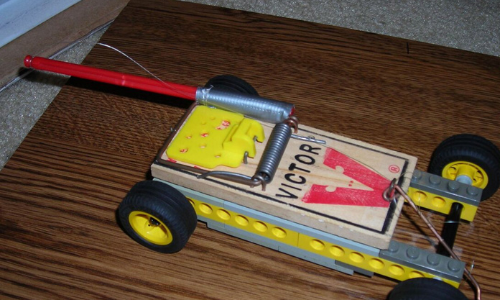Live
- Pakistan's Lahore remains world's most polluted city despite light drizzle
- Asha Nautiyal retains Kedarnath for BJP, to be back as MLA after 12 years
- India leads world in science, innovation research: Minister
- Flash flood in Indonesia's South Tapanuli claims two lives
- MahaYuti's electoral success testament to leadership of PM Modi, HM Shah: Ajit Pawar
- Unproven remedies: Tata Memorial Hospital slams Sidhu’s viral ‘diet cure’ cancer claim
- People voted in favour of development, rejected negative politics: CM Shinde
- Rajasthan bypolls: CM Bhajan Lal Sharma's governance credited with BJP's impressive show
- Aaditya Thackeray retains Worli defeating Shinde faction nominee Milind Deora
- Over 20 Injured in Multi-Vehicle Collision on Mangaluru-Bengaluru Highway
Just In

Can you take the energy from a mousetrap and use it to power a car Try it out This project results in a very simple mousetrap car It probably wont go very far or fast, but itll help you learn the basics of how this type of car works Then you can try your hand at building a more complex car See some ideas at the end of the project
Can you take the energy from a mousetrap and use it to power a car? Try it out! This project results in a very simple mousetrap car. It probably won’t go very far or fast, but it’ll help you learn the basics of how this type of car works. Then you can try your hand at building a more complex car. See some ideas at the end of the project.
What You Do: Have an adult help you use a utility knife to cut four wheels out of a piece of foam board or corrugated cardboard. Make the back wheels about double the diameter of the front wheels. (Use a compass to draw the circles, or trace around a bowl or cup.) Give your wheels some traction by stretching large rubber bands around each wheel. For the small wheels, you could also try using a section of a balloon.
If there are metal or plastic teeth on the mousetrap, remove them carefully using a pair of pliers. Also, remove the rod that is used to set the trap. Start building the base, or chassis, of the car by cutting a piece of strong cardboard so that it is slightly bigger (about 1/2″) than the mousetrap on every side. Use duct tape to attach the mousetrap to the base. Don’t cover up the spring in the middle of the trap or the “snapper arm.” Screw the eye hooks onto the bottom of the cardboard chassis, one in each corner. Use a ruler to make sure that the eye hooks are aligned with each other.
Cut the wooden dowel so you have two pieces that are both about two inches longer than the width of the chassis you have made. These will serve as your axles that rotate the wheels. Stick the dowels through the eye loops. Make sure that the axles are straight and that there is room for them to spin in the eye hooks. Cut holes a little bit smaller than the dowel through the center of each wheel, then attach the wheels to the base. Put the large wheels on the back of the car, opposite the snapper arm. Wrap a small rubber band around the axle on either side of each wheel so the wheels can’t fall off.
Tie a string very tightly to the snapper arm on the mouse trap. The string should be long enough to just reach to the back axle. You may need someone to help you with this last step. Carefully pull back the snapper arm until it reaches the other end of the trap. Hold it in place while your helper wraps the string tightly around one side of the axle. Holding the string tightly, set the car on the ground and carefully let go of the trap – the string should be wound tight enough that it holds the trap in place. Next, make sure everyone’s hands are out of the way and then let go of the string. The trap will snap forward, propelling your car.
What Happened: A set mousetrap is full of potential energy which, when released, is converted to kinetic (motion) energy. The design of your car allowed that energy to be transferred to the axle to make the wheels turn. When the trap snapped closed, it yanked the string forward. As the string was pulled, friction between it and the axle caused the axle to rotate, spinning the wheels and moving the car forward.
There are many different ways to build a mousetrap car. Your simple model moves forward a few feet, but how could you design it to go longer distances? Or how could you design it to go faster? Here are some things to think about: wheel-to-axle ratio. For distance cars, larger wheels are best. Every time your axle turns one time, so do your wheels — if the wheels have a much larger diameter than the axle, the car will go further on each turn of the axle than it would if the wheels were smaller. It takes more force to accelerate a car with a large wheel-to-axle ratio, so smaller wheels will work better if you want your car to be fast.

© 2024 Hyderabad Media House Limited/The Hans India. All rights reserved. Powered by hocalwire.com







